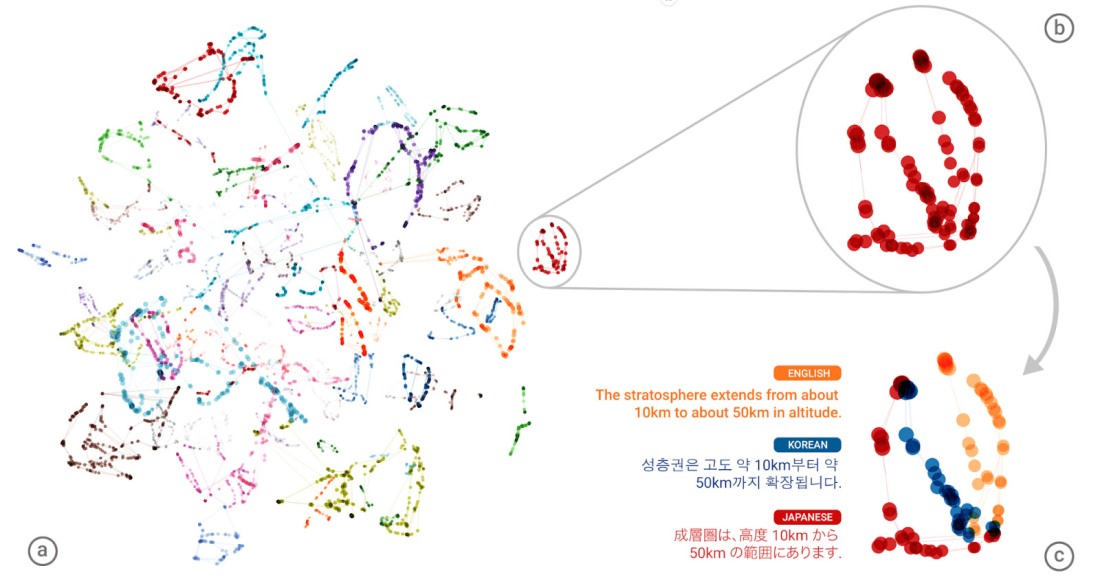
So you’ve seen this news [New Scientist/Wired], right? That the Google Translate AI has supposedly invented a new internal language to help it translate language pairs it hasn’t learnt. Having been taught English <> Japanese and English <> Korean, it can then do the job for Japanese <> Korean.
The headlines position this as the AI inventing its own internal language, or interlingua, to handle those conversions. Every article notes the difficulty in anyone knowing exactly what is happening in there, the deep learning that’s going on inside the AI. (Engadget had the slightly more nuanced report on this, further from the “invented a language” headline.)
An invented language? That’s one interpretation. But if a language consists of signs, symbols that exist in the world, is that the best description for the process?
So Google Translate learns that English table means both Spanish mesa and Swedish bord. Does it then need to tell itself:
IF table = 1010101011101 = bord
AND table = 1010101011101 = mesa
THEN bord = 1010101011101 = mesa
?
That’s not how we meat-sacks use language. It skips over another interpretation, lacking from the reporting I’ve seen so far, which is either totally thrilling or utterly chilling, depending on whether or not you’re looking forward to the ascendancy of Skynet.
I (and I’m willing to assume you too) have an idea of a table, based on years of experience:
- It’s a flat surface atop a number of legs (often 4);
- It’s usually (not always) around thigh height;
- Most are made of wood, or metal, or plastic;
All these things contribute to a mental representation of [table]: a confluence of images, physical experiences, language labels, and a heap of Venn diagrams of different properties that coalesce around the label of table. A lot of overlap with something like [chair]; less – but some – overlap with [dog]. A mess of connections and firings in the neural pathways, impossible to pin down, even while it’s possible to see where they cluster.
The Platonic form of a table, if you like. That is what’s triggered when I hear the English or Spanish or Whateverish word for [table]. English is my mother tongue, but if I were to translate a Stockholm restaurant reservation for a Spanish speaker, the mental process wouldn’t be “(Swedish) bord = (English) table = (Spanish) mesa”. It would be “bord <> [idea or Platonic form of the table] <> mesa”.
Look at that map up top again. That string of Japanese word/concepts on side, the English string on the other, the Korean somewhere in the middle but tending closer to the Japanese. The whole forming a neat oval, a cluster of meaning. OK, so the AI only has language input, there are no sights/feelings/memories of [stratosphere] associated, not yet.
But what if that oval, that pattern of pinpricks of understanding, represents the rough formation of a Platonic form; an AI idea?
F**k. The singularity approaches…
I don’t quite grok your question: like, isn’t a platonic table (the perfect table, rotating out there in the platonic realm of forms, aka IKEA) something like the opposite of what’s happening with this language and other brute force approaches to AI, where we have something more like an *inferential* table, where the AI makes a statistical judgement based on huge data sets?
I think I will ponder this more over some platonic noodles… L
LikeLike
Hmm. Hopefully you haven’t mistaken me for
a tablesomeone who knows vad i helvete they’re talking about. I mean, I’m no deep learning programmer savant, but in this post-factual, death to experts world, presumably that makes me an authority.But don’t *we* learn language by collecting huge data sets and making inferences, until that reliably solid (so perhaps not from IKEA) idea of a table coalesces?
It just seemed that the thrust of the news (“Google Translate invented a language”) felt misleading – a grabby headline that didn’t do justice to what might actually be happening there. Plus ça change.
LikeLike
The fact you can think *and* type means there’s hope for tables everywhere. But you’re right, there’s a waaay more interesting story here than Google invents a language.
“But don’t *we* learn language by collecting huge data sets and making inferences, until that reliably solid (so perhaps not from IKEA) idea of a table coalesces?”
Hm I dunno, do we? Like, how many fish would you need to have seen before you recognise that Nemo, a bath toy, and just me wriggling my hand sinusoidally can all be examples of ‘fish’?
LikeLike
“Sinusoidally” = up your nose?
Watching C., it’s the things she’s seen (and heard the word for) most often that she’ll learn to say first. Then she applies that label to other things, to see if they fit in the category too. All non-family women/men in pictures are mamma/pappa (accordingly).
LikeLike